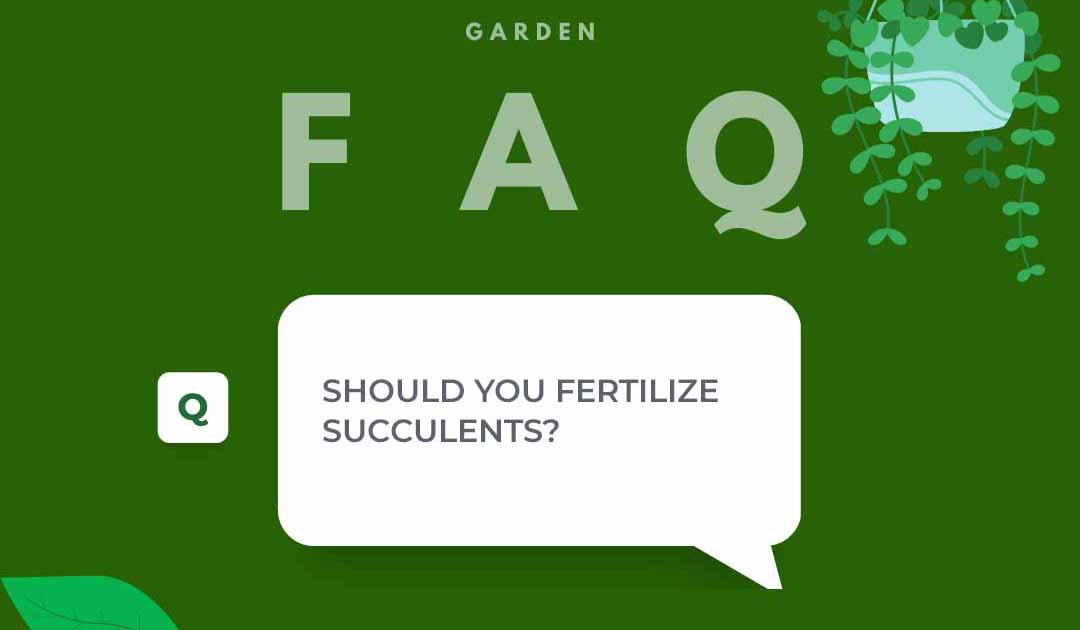Succulents are one of the most popular plants for both indoor and outdoor gardens, and for good reason. They’re often seen as “easy” plants that are generally low maintenance while also looking beautiful and exotic. While this is true, if you’re willing to put in a little extra effort you’ll be well rewarded with faster growth and beautiful plants. Today we’ll be looking at whether you should fertilize your succulents, as well as some other common questions around feeding your succulents and cacti.
Should You Fertilize Succulents?
The answer is yes. While succulents are generally low maintenance, fertilizing them can help encourage thick, lush growth. You don’t need to feed them frequently, a little bit goes a long way.
I recommend that all gardeners fertilize their succulents at least once per year. It’s a very easy and quick piece of care, but it can have a big effect on how well your succulents grow.
By fertilizing your succulents you’re providing them with a fresh dose of much needed nutrients. These are essential to help replenish the soil, especially for those grown in containers. Overtime, container soil will lose nutrients and become lifeless. By fertilizing it, you add nutrients back into the soil, which gives your plant more to absorb allowing it to continue its growth.
What Type Of Fertilizer Should You Use For Succulents?
You have a few options for fertilizer, any of which can provide good results. First off, you can use a standard commercial fertilizer. When doing so you’ll want to dilute it to about half strength. Too much fertilizer can burn out succulents, especially small, container grown ones. Diluting down the concentration reduces this risk.
There are also a number of cacti and succulent specific fertilizers available on the market. These are specifically formulated for these types of plants, and are another good option. Follow the instructions on the container when using these types of fertilizers.
Lastly, you always have the option to use [your own compost]https://www.theindoorgardens.com/getting-started-with-compost/ if available. This is a great organic option, and doesn’t run the risk of burning out the plant like some chemical fertilizers will. Many succulent growers will make a manure tea, and use that to feed their plants, but other types of compost will work just as well.
How Often Should You Fertilize Succulents?
It depends on the species, but generally you’re going to want to feed your succulents once at the beginning of their growing season which is usually spring. Succulents are slow growers and don’t need a ton of nutrients, so this is usually enough.
If you’re growing outdoors in a very sunny location you can feed them a second time in the middle of the season. This should usually only be done for those that are getting enough sun to sustain lots of growth, and that typically means those outdoors in bright sunlight.
In any case, you should only be applying fertilizer in conjunction with watering if not using an organic compost. You don’t want to apply chemical fertilizer to dry soil as this can burn out your plant. Make sure to give your plant a healthy dose of water at the same time you’re fertilizing to prevent this.
You also want to avoid adding any fertilizer when the plant isn’t actively growing. In most cases, this is in the fall and winter. Most succulents will go dormant during this time and slow down their growth to conserve energy. This means they need less nutrients, so likely won’t see any benefit from being fed during this time.
Dealing With Stretching
Lastly, a common issue many succulent growers face is having them grow taller but not outwards. This ends up looking like the plant is stretching and looks less than ideal. In certain cases, it can also be dangerous to plant as they lack the support to hold themselves up.
This is often caused when a plant has enough nutrients to grow, (such as right after being fertilized) but isn’t getting enough light. The plant is trying to “reach” out to the source of the light in an attempt to get more.
The solution is to simply make sure your plant is getting enough light, especially following a recent fertilization. You can either move to a sunnier location, or use grow lights to help supplement natural light.
More Succulent Reading
If you’re interested in learning more about succulents check out our beginners guide to growing them. In it we detail everything you need to know about succulents, and all the care tips you’ll need to keep them healthy all year long.
Succulents are very low maintenance plants, and many will happily sit for years with only minimal care. However, if we take that little extra step to feed them we can get some truly spectacular results. A well fed succulent will grow big and healthy, and make an excellent decoration in your next garden.







